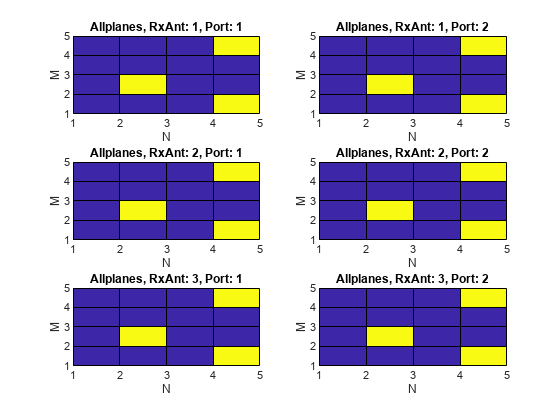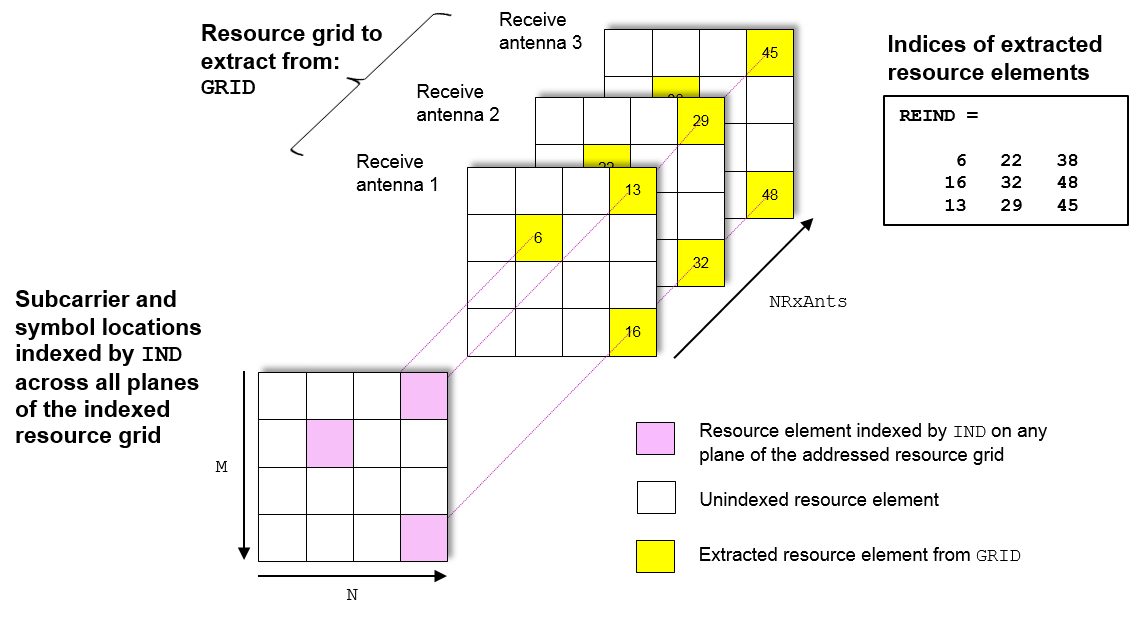lteExtractResources
Extract resource elements
Syntax
Description
[
extracts resource elements re,reind] = lteExtractResources(ind,grid)re their indices
reind from resource array grid using
resource elements indices ind. You can extract resource
elements from a resource grid with different dimensionality than the resource grid
addressed by the indices. The indices specified and returned are in 1–based linear
indexing form. Other indexing options are available. The resource extraction process
is further explained in Algorithms.
LTE Toolbox™ generates indices for mapping sequences of physical channel and signal
symbols to a resource grid. The software generates these indices using channel- or
signal-specific functions and address resource elements in an array of size
M-by-N-by-P.
M is the number of subcarriers, N is the
number of OFDM or SC-FDMA symbols and P is the number of planes.
The diagram highlights the resource elements of a resource grid addressed by
indices, ind. The indices are in a 1–based linear indexing form.
P = 2 is the number of antenna ports.

Typically the resource array extracts resource elements from one of the following:
A 3-D received grid, sized M-by-N-by-NRxAnts. NRxAnts is the number of receive antennas. This grid is created after OFDM or SC-FDMA demodulation.
A 4-D channel estimation grid, sized M-by-N-by-NRxAnts-by-P. This grid is created by channel estimation functions (refer Channel Estimation).
You can describe the size of the 3- D received grid as a 4-D grid that has a trailing singleton dimension.
Examples
Input Arguments
Output Arguments
Algorithms
Version History
Introduced in R2014b
See Also
ltePUSCHDecode | ltePUSCHIndices | ltePDCCHDecode | ltePDCCHIndices | ltePBCHDecode | ltePBCHIndices | ltePDSCHDecode | ltePDSCHIndices | ltePDCCHDecode | ltePDCCHIndices | ltePCFICHDecode | ltePCFICHIndices | ltePHICHDecode | ltePHICHIndices | lteCellRSIndices | lteSCFDMADemodulate | lteOFDMDemodulate | lteDLChannelEstimate | lteULChannelEstimate | ltePUCCH1Decode | ltePUCCH1Indices | lteULChannelEstimatePUCCH1 | ltePUCCH2Decode | ltePUCCH2Indices | lteULChannelEstimatePUCCH2 | ltePUCCH3Decode | ltePUCCH3Indices | lteULChannelEstimatePUCCH3 | lteDLResourceGrid | lteULResourceGrid







